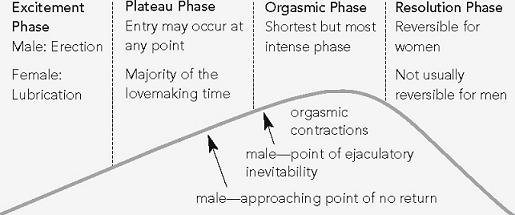
To help us understand the physical aspects of sexual response, Masters and Johnson were the first to define the sexual response pattern in four specific phases. These are the excitement, plateau, orgasm, and resolution phases. Although sexual experiences usually begin with sexual desire that precedes the excitement phase, desire is mainly an emotional response and hence will be dealt with in Chapter 9. The four phases of the sexual response cycle we will be discussing here are not distinct in terms of how we experience them. There is no “click” as we move from one phase to the next (see graph on next page). Physiologically, the intricate details of men’s and women’s sexual responses confirm God’s masterful creative work.
1. The excitement phase has to do with our initial arousal. It is most clearly evidenced by an erection in the man and by vaginal lubrication in the woman.
2. The plateau phase, which is ideally the longest phase of the lovemaking process, is the period of love play during which arousal intensifies in preparation for the sexual release.
3. The orgasmic phase, the briefest, most intense, and most internal phase, is the release.
4. Finally, there is the resolution phase, during which the body returns to its unaroused state.
The specific physical changes that occur are basically the same from one woman to another and from one man to another. However, every person differs from one experience to the next, and there are certainly differences from one person to another. These differences primarily occur in timing, intensity, and feeling.
The responses that occur—the changes in the body—may be as a result of sexual intercourse, manual or oral stimulation, self-stimulation, caressing, deep kissing, fantasies, dreams, or visual input. Sexual intercourse is not necessary for a full sexual response, nor does intercourse ensure a full sexual release.
SEXUAL RESPONSE PATTERN1

EXCITEMENT
The Female Response
Let’s begin by looking at what happens to the woman during the excitement phase. Excitement can result from either physical or emotional stimulation. When this stimulation is received and enjoyed, sexual arousal produces external and internal changes. First, in the external genitalia, we note that the clitoris is probably the most important organ during the excitement phase. As you will recall, the clitoris is a unique organ in the human anatomy in that its only purpose is the receiving and transmitting of sexual stimuli. With arousal, the clitoris becomes engorged or enlarged, just as the penis becomes erect. The clitoris increases two to three times in length and size. Hunger for clitoral stimulation may result. Most women report that the caressing of the general area around the clitoris is more desirable than having the head, or glans, of the clitoris directly manipulated.
Other changes that occur in the external genitalia during the excitement phase are in the lips, both the inner and the outer. The outer lips, or the labia majora, spread out flat as if opening up in preparation for receiving the penis. The inner lips, or labia minora, increase in size, extend outward, and become slightly engorged, forming a funnel shape. (To identify clitoris, inner lips, and outer lips refer to Figure 1 on page 46.)
The breasts, too, change during the excitement phase. They usually enlarge, becoming more rounded and full, with obvious nipple erection. This is one of the indications that we encourage a couple to watch for if the woman reports she is not experiencing any sexual arousal. What we often find is that the woman is in fact becoming physically aroused, with both lubrication and nipple erection. However, she is not aware of any feelings and hence reports a lack of arousal. As she becomes aware that she is responding physically, at least in the excitement phase, she can be encouraged to affirm her responsiveness and become more aware of the sensations associated with her arousal.
Moving to the internal genitalia, we begin with the vagina, which responds by lubricating within ten to twenty seconds after stimulation is received. Although lubrication has been thought of as the sign of readiness for entry, entry is not likely to be desired or recommended until much later. The lubrication that occurs can be understood by thinking of it as perspiration—little beads of lubrication that form along the walls of the vagina (see Figure 6 on the next page). Their simple function is to reduce friction and enhance the pleasure of the penis in the vagina.
The cervix, which is situated at the back of the vagina, is the opening to the uterus. As the uterus elevates with increased arousal, it begins to pull away from the vagina so as not to be in the way of the penis during thrusting (see Figure 6). When the woman happens to have a tipped or retroverted uterus, this pulling up and away of the cervix is less likely to occur because the uterus cannot elevate as it is supposed to. Thus, the woman with a tipped uterus may experience pain upon deep thrusting. A change in position during intercourse can lessen the likelihood of the penis striking the cervix. Exercises and help from the physician may be necessary to correct a tipped uterus.
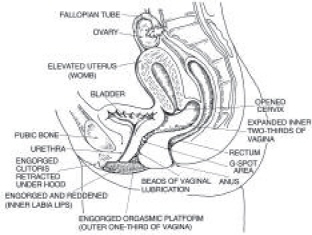
Figure 6: Aroused Internal Female Genitalia (Side View)
The Male Response
The penis, like the clitoris, is the receiver and transmitter of sexual feelings. The main male response during the excitement stage is penile erection (see Figure 7 on page 74). To define it simply, the unstimulated or flaccid penis becomes erect as the man receives stimulation, either physically or emotionally. The erection occurs as a result of the blood that flows into the penis and is held there in the veins by valves that keep it from flowing back out as long as there is arousal. Erections can be maintained for extended periods of time without ejaculation, if the man is not anxious, and when the stimulation is varied, both in terms of its type and its intensity. Note that the intensity of the erection will tend to fluctuate over a period of time and may be lost and regained during extended love play. The only factor in the way of regaining an erection would be anxiety about the loss of the erection, or some external event that may have interrupted the sexual experience. Erections are emotionally tenuous. An erection can be stopped very easily when some nonsexual event occurs such as the telephone ringing, a knock on the door, a change in the lighting, or any other interruption. Even a sharp critical comment can make the erection diminish.
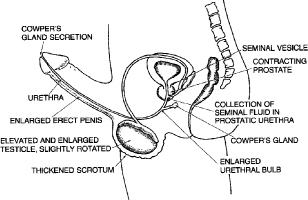
Figure 7: Aroused Internal Male Genitalia (Side View)
The other change that occurs for the man during sexual excitement is the thickening of the skin around the testicles. This is believed to occur in order to increase slightly the temperature of the seminal fluid as it is prepared for expulsion and fertilization of the egg.
About 60 percent of men also experience nipple erection. However, since a man’s breasts are less prominent, the nipple erection is usually not as noticeable in the man as it is in the woman.
Sex Flush
One other bodily change that may take place in both men and women during the excitement phase is called a sex flush. It is a blushing or reddening that occurs over the upper third of the body—the chest, neck, face, and forehead. It is more likely to occur in a room where the temperature is slightly elevated and in situations of extreme anticipation. This is observable in some men and women and not in others. It is not fully understood why the flush occurs for some people; it may be the result of complexion differences. We would hasten to add that it is not a matter of concern whether one does or does not experience the sexual flush; this may simply be an additional sign for some that sexual arousal is taking place.
PLATEAU
The Male Response
In the male, during the plateau phase the coronal gland or head of the penis deepens in color, due to greater engorgement, and continues to enlarge. During this time of extended love play, a small amount of pre-ejaculatory fluid seeps from the penis. (This fluid contains live sperm that can impregnate the woman. Because of this, withdrawing the penis from the vagina before ejaculation is not a safe method of birth control.) The skin of the scrotum continues to thicken, and the right testicle pulls in closer to the body and rotates about a quarter of a turn during the midpoint of the plateau phase. There is also a significant increase in the size of the testicles (see Figure 7).
Internally, the seminal fluid begins to collect in the area around the prostate gland. As the man moves through the plateau phase toward the point of orgasm, he begins to feel that he is reaching ejaculatory inevitability, or the point of no return (see Sexual Response Pattern graph on page 71).
The Female Response
During the plateau phase, the woman continues to enjoy stimulation. Some prefer a brief time of pleasuring while others prefer a longer period of love play. This is one of those needs or desires that seem to vary from one person to another, and in the same person from one time to another. It is important to recognize that many women experience their building sexual arousal in a way that might best be described as waves. There is a peak and then an ebb or diminishing of the intensity of feelings—and then a new wave of sexual arousal. If a woman lets herself ride the waves, the peaks will tend to intensify. However, if this wavelike diminishing of sexual feelings is thought to be the end of her arousal, the woman may become anxious and stop her response from occurring in its natural wavelike pattern. The anxiety fulfills her fear. It, then, does end her arousal.
The signs of breast engorgement and the sexual flush, which were noted in the excitement phase, continue. Most of the changes take place in the internal genitalia. There are a few changes that should be noted externally first. The inner lips become bright red and increase in size. This occurs about one minute before an orgasm. The clitoris continues to be enlarged, but draws up or retracts under the hood and, as the arousal continues, becomes more difficult to locate. It is often extremely sensitive to being touched directly.
Internally, a number of significant changes take place. The uterus becomes fully elevated or pulled into position ready for the orgasm, with the cervix being pulled away from the thrusting penis (see Figure 6, page 73). The most important changes take place in the vagina. Blood rushes to the outer third of the vagina, causing it to become densely engorged and contract, forming what is called the orgasmic platform.
It is as if God designed the vagina for both pleasure and procreation. In terms of the reproductive purpose, the upper, inner two-thirds of the vagina balloons out and forms a pool to keep the seminal fluid containing the sperm inside the vagina. As the woman responds, the uterus, which lifted up and away earlier, now falls into the seminal pool, and the cervix of the uterus opens so the sperm can travel up through the cervix into the uterus for fertilization. For the pleasure purpose of intercourse, the tightening of the external third of the vagina functions as an extra stimulation to the penis and the vagina. This outer portion of the vagina thickens, contracts, and produces a grasping effect, holding the penis firmly in the vagina. It is important to note again that since this orgasmic platform includes only the first third of the vagina, or about an inch and a half to two inches, the preoccupation with penis size is of little real consequence. The most important part of the vagina for penis contact is this orgasmic platform area, which at the most is two inches in length and can tighten or expand to any width.
ORGASM
This is the phase that elicits the most attention. It is the most intense phase of the sexual experience, yet it lasts the shortest period of time and is experienced mainly internally and individually. The orgasm does not focus on the relationship. This is often the phase talked and written about as the ultimate and central part of the whole sexual experience. Yet we have talked with many couples who, although they have little difficulty with orgasm, are very unsatisfied with their overall sexual experience. So as we begin the discussion of the orgasmic phase we want to look at it in proper perspective.
We see the orgasm as an essential ingredient when there is intense sexual arousal. It is important, but not something that is to be focused on to the exclusion of all the other phases. Some women, particularly more passive or low-key women, find pleasuring and affirming more necessary than release. Men over age forty may end a sexual experience feeling fulfilled without an orgasm. The orgasm is a reflex response. An orgasm is not a response that we can will, but if we allow the right kind of stimulation, we can expect that the reflex of the orgasm will follow (see Chapter 17).
The Female Response
As a woman moves into the orgasmic stage, various changes happen within the body. The clitoris and inner and outer lips remain basically the same as they were at the end of the plateau phase. The genitally centered feelings of the orgasm (see Chapter 17) are due to the strong vaginal contractions in the orgasmic platform. Masters and Johnson have measured three to five contractions for a mild orgasm and eight to twelve contractions for an intense orgasm. These contractions occur at intervals of eight-tenths of a second. This is true for all women and is the same as the spacing of the contractions in the man. As the outer third of the vagina is contracting, the inner two-thirds is expanding even farther to form a place for the seminal fluid.
Women have two centers of orgasmic response. The orgasm is experienced not only in the vagina but also in the uterus. The uterus undergoes contractions similar to the first stages of labor. Some women have reported that they experience a dull pain in their lower abdomen. This may be due to the uterine contractions that occur. Once a woman’s fears have been allayed through the explanation that this is a normal response, she learns to enjoy the intensity of those contractions rather than to experience them as painful.
We knew a highly intense woman who was very responsive in the initial phases of the sexual experience, but then, as she moved into the orgasmic response, she would draw back from further stimulation to avoid the lower abdominal discomfort. This had been true of the first eight years of her married life and was particularly noticeable when she was extremely aroused. As she learned to relax and let herself enjoy the abdominal feelings, her experience shifted from sensing the contractions as pain to experiencing them as intense pleasure. This confirms the close relationship of pain and pleasure in our bodies. Just as a very intense pleasurable sensation can easily shift to being painful (refer to graph on page 47), a painful sexual feeling may change to intense pleasure.
While the centers of the orgasmic response are in the vagina and the uterus, the sensations that grow out of this center cover the whole body. It is analogous to dropping a rock into a pool of water. The most intense reaction is at the center where the rock is dropped, but the reaction continues to move out in wider and wider circles.
These total-body responses occur in both men and women. Many of these begin during the plateau phase and reach their peak with orgasm. Let us enumerate them. The heart rate increases up to 180 beats per minute. The blood pressure often rises measurably. The breathing intensifies, becoming deeper, faster, and noisier (hyper- ventilation). There may be a great deal of involuntary muscular movement—thrusting of the pelvis and spasticlike contractions of the face, arms, legs, back, or lower abdomen. There is a specific response that occurs in the foot called a carpopedal spasm, which is a straightening out of the foot in a clawlike contraction, where the toes curl downward and away from the body (hyperextension). These are all involuntary responses that are orgasmic triggers.
Many times the contractions of the face, particularly the mouth, are of great concern to women. Some women like to make love with the lights out because they do not want to be seen making these “unladylike” responses. In the face, the contracting muscles sometimes give the appearance of a frown, scowl, or grimace. The mouth may open involuntarily with a gasping kind of reaction that often includes some involuntary sounds or words. Once a woman can accept the fact that all these reactions and noises are a natural part of the sexual response, it may become easier for her to let herself be responsive with her husband. Many women are surprised to find that rather than turning off their partners, these bodily responses will usually heighten a man’s arousal.
Vaginal vs. Clitoral Orgasm. Much has been written and many misconceptions have been passed on about various kinds of female orgasm. It is important to understand the background of these myths. When Freud was developing his psychoanalytic theory, in some of his writings he defined the woman who had achieved orgasm only through external or manual stimulation as an “immature woman”—in fact, a little girl. He said that as a woman matured into full womanhood she would obviously have her orgasm in the “normal” adult manner: that is, as a result of vaginal penetration through intercourse. These concepts have been disseminated throughout the Western world and used to put pressure on women to experience orgasm during sexual intercourse. The research of Masters and Johnson has proved Freud’s theories to be physiologically inaccurate, and thus has diminished the potency of Freud’s argument from a psychological perspective.
Masters and Johnson found that there is only one kind of orgasm a woman can experience. All orgasms, regardless of the source of stimulation, are exactly the same in terms of their physical components. When a woman has an orgasm, whether it is the result of her thoughts and fantasies, self-stimulation, breast stimulation, manual stimulation by her partner, or intercourse, exactly the same things happen to her body as were just described. There is the formation of the orgasmic platform, the contractions in the outer third of the vagina, the contractions of the uterus. All the bodily responses occur regardless of the source of stimulation.
Since Masters and Johnson’s research, women have reported a difference in sensation between an orgasm from internal, vaginal stimulation and one from external stimulation. The reports on G-spot-stimulated orgasms indicate that those are different from orgasms resulting from external stimulation.
The G-spot, an area named after Dr. Ernst Grafenburg, was written about in medical literature in the early 1940s but then left unnoticed for forty years. This area is located on the upper inside of the vagina just beyond the upper, inner edge of the PC muscle. When a woman is aroused and the G-spot area is stimulated by her husband’s penis or finger, she may respond with a very intense orgasm that tends to feel like a bearing down sensation. For some women, this intense response is accompanied by a release of fluid called a flooding response or female ejaculation.2
Some women who have experienced orgasm from both external and internal stimulation report that they find these two to be different on an emotional level. For them the orgasm during intercourse is more fulfilling than the orgasm brought about by external stimulation. This is a matter of personal preference for a woman. There is nothing wrong with striving for an orgasm during intercourse, unless that becomes an inhibiting effort. There is also nothing wrong with being satisfied having an orgasm as a result of external stimulation. In fact, some women report a more intense response when the penis is not in the vagina.
Many times the pressure on a woman to experience orgasm during intercourse is a serious deterrent to full satisfaction. This pressure may come from a husband who feels he is less of a man because he can’t get her to have an orgasm during intercourse. It is as though his worth is dependent on achieving this goal. This mentality is in contrast to our suggestion that each person be responsible to pursue his or her own sexual desires as long as it is not at the expense of the other.
The Male Response
We have said that during the excitement and plateau phases the man’s penis becomes erect, the skin of the scrotum thickens, the right testicle rises and rotates toward the body, and the seminal fluid begins to gather. The male orgasmic phase can be described as having two stages:
Stage 1: As a man nears the end of the plateau phase and moves into the orgasmic phase, he begins to notice that some changes are taking place. He senses that he is getting ready to ejaculate. Most men can identify when this occurs, though they usually do not know what is happening to their bodies. They are approaching the point of no return.
A number of changes take place during this first stage of the orgasmic response. Contractions in the prostate gland occur at intervals of eight-tenths of a second. The outlet (sphincter) from the bladder closes off so none of the seminal fluid will be pushed back into the bladder nor will any urine escape during ejaculation. Most men are aware that immediately before or after an ejaculation it is almost impossible to urinate. This is because the opening from the bladder has been closed in preparation for the ejaculation. Another change now takes place. The left testicle pulls up toward the body and rotates about one quarter of a turn (the right testicle elevated during the plateau phase; see Figure 7, page 74). All these changes take place in a few seconds. They are warnings to the man that he is about to ejaculate. In addition to these warnings, the seminal fluid gathers near the base of the penis in readiness for expulsion during the contractions that occur in the second stage of the orgasmic phase.
Stage 2: When a man reaches the point of no return, or ejaculatory inevitability, the ejaculation will take place. He can try to stop, the phone can ring, or a bucket of water can be dumped on his head, but he will ejaculate! The ejaculation consists of contractions along the seminal duct system and the penis, which force the seminal fluid out the end of the penis. In younger men the force is more intense, causing greater spurts. The force of the ejaculation decreases with age. The contractions of the penis and seminal duct system are eight-tenths of a second apart. Men usually experience five or six such contractions, with the second and third usually the most intense. The expelled seminal fluid contains between 150 and 350 million living sperm, which will stay active within the vagina up to ten hours after expulsion.
Differences Between Male and Female Response
With every discussion of male/female differences, there will be exceptions. You may be one of those. As you read what is typical for women or what is typical for men, you may be saying, “But that isn’t true for us.” If the findings we report here don’t fit the two of you, use this information to define your uniqueness and difference as a husband and wife. When we understand and embrace our differences as men and women, we minimize conflict and false expectations and maximize the enjoyment of our orgasmic response.
Differences between men and women in their orgasmic response:
• For women, the orgasmic response is a total-body experience with a flood of warmth throughout the body, whereas men tend to have primarily intense genitally focused sensations during release.
• Women vary in their orgasmic expression. They vary from one woman to another and from one time to another. Men seem to be more predictable and consistent in their expression of an orgasm.
• Women have the potential to respond indefinitely—with multiple and sequential orgasms. Not all women desire or feel the need for more than one response, but some do. In contrast men, except for about 1 percent, need a refractory period of at least twenty minutes. Usually it is several hours before they can regain arousal, erection, and release. Although, the authors of The G Spot say men can learn to have multiple orgasms, we would be hesitant to encourage that as a goal lest it become a demand.3
• A woman’s orgasm can be interrupted at any point; once the man starts his ejaculatory response, he will ejaculate! Nothing can stop his ejaculation. Men can control their actions and they also can learn to control their response before they reach that point of ejaculation.
• The longer the time between sexual experiences with release, the wider the gap between men and women in their eagerness and responsiveness. If a sexual experience is the first in a long time, a woman will be less aware of her need for sex and tend to be slower in her arousal and have more difficulty letting go. A man’s felt need for sex intensifies and he will tend to move quickly to arousal and release. Because of this tendency for men and women to go in opposite directions, we believe we were created to have sexual release regularly. The biblical teaching in 1 Corinthians 7: 3–5 affirms the importance of coming together on a regular basis.
• Women experience more difficulty with and pressure to have an orgasm. Men experience little difficulty with having an orgasm, but more with controlling the timing of their orgasms. Their pressure is to get and keep an erection and delay ejaculation.
RESOLUTION
The Female Response
For the woman the resolution phase varies significantly, depending on whether or not she has had release. If she has had an orgasmic release—whether this has come about as a result of manual stimulation or intercourse—the body goes into a rather quick period of tension loss. Everything moves in the reverse of what has occurred throughout the excitement, plateau, and orgasmic phases. The whole genital area is relieved of tension and congestion. That is, the extra blood flows out of the area. The woman may feel a tingling sensation as this happens. The vagina, cervix, and uterus move back into their prestimulated stage, and the woman’s whole body is relaxed.
If the woman has not had an orgasmic release, the resolution phase takes much longer. Some doctors have reported that the engorgement can last well beyond several hours. Many women will experience a significant amount of tension during this extended resolution period. A woman may cry, thus providing the physical and emotional release denied her by the lack of orgasm. Her crying may cause her to turn away from her husband in shame. This turning away is just the opposite of what both she and her husband need: warmth, affirmation, and reassurance. The human body is designed for sexual release; if arousal takes place without release, it is likely to cause discomfort. That discomfort can best be handled through mutual expression of care and affirmation.
If you are a woman who consistently experiences arousal without release, it is crucial that you share this with your husband. Let him know what your body feels like so the two of you can move closer together. There can be some relief just in being reached out to. He needs to know what you need.
What about multiple orgasms? A woman’s body is designed so that she can have another orgasm at any point of the resolution phase. It can be five seconds, five minutes, or fifty minutes after the previous orgasm. There is no waiting or rest period necessary before she is physically capable of experiencing another orgasm if the stimulation is continued or renewed. Her body does not need to return to its prestimulated state before it can be responsive again. This is not to say that having more than one orgasm is better, or that sexually “together” women will desire this. The point is that, physically, if she desires it and can allow it, the woman’s orgasm can be repeated indefinitely.
The Male Response
After orgasmic release, the man returns rather quickly to the prestimulated state. His erection may not decrease completely, but the penis is usually somewhat flaccid and the testicles lower. There is a loss in the tension buildup and in the intensity of feelings. Some men report that the glans or head of the penis becomes very sensitive to touch after an ejaculation and because of this, they want to quickly disengage from their partner. The man may not have told his wife this because he feels uncomfortable or embarrassed about it. It is important to know that a significant number of men feel this postejaculation pain. If you experience such discomfort, it is crucial to share this with your partner so she can be sympathetic and understanding rather than taking your withdrawal as rejection.
It is rare for a man not to experience orgasm. However, there are some men (especially older men) who do not need an orgasm and do not feel frustrated without one.
GRAPHING THE SEXUAL RESPONSE
Throughout this chapter, we have described what happens to men and to women in each of the four phases of the sexual response cycle. The graphs for men and women on the following pages demonstrate these phases.
The curved graph on the top of the next page that summarizes the sexual response pattern of men’s bodies to positive stimulation represents a composite of responses rather than any individual man’s response.
The male sexual response pattern might look more like the chart at the bottom of the next page.
There is not much variation among men in the intensity of the response they experience. There is considerable variation, however, in the amount of time each phase might take. Thus the graph might be spread out more or it might be compacted into a briefer experience, but the height of the intensity in each phase would tend not to vary much.
Just as the curved graph for men is a composite of all men, so is the women’s graph on page 87. However, women vary infinitely in both the amount of time each phase might take and in the intensity of the response.
Using four simplified patterns, we have represented the possible ways a woman might respond. These closely represent most of the responses graphed by women who have attended our seminars. To see these patterns, refer to the graphs on the following two pages.
SEXUAL RESPONSE PATTERN FOR MEN4

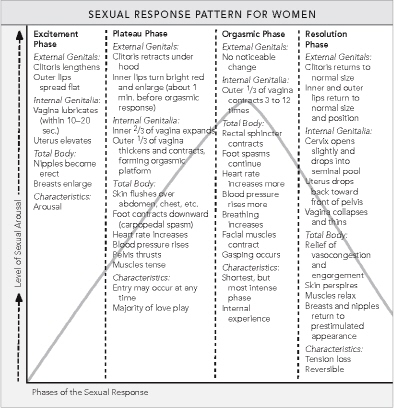
The first graph pictures the woman who is quickly aroused. She experiences her arousal building in peaks followed by short dips, and with effective stimulation moves rapidly to an intense orgasmic release. As her buildup is rapid and her release intense, so she also returns to her prestimulated state (resolution) rather quickly. The woman with this intense response pattern may feel satisfied with one release, as the graph depicts. A few women may have the drive to pursue more love play with repeated arousal and response.
The second graph is a description of the woman who enjoys extended love play before she goes after the intense arousal that would trigger an orgasm. Her arousal may intensify upward rather steadily, as the graph demonstrates. One variation may follow the same general pattern, but the woman may experience her upward intensity in waves that have flowing dips, as the dotted-line graph would indicate. As the sex drive and tension build, whether steadily or in waves, this woman experiences an orgasmic release with very little tension loss, and she is quickly stimulated to the point of another orgasm. This may happen twice, as the graph shows, or as many times as she desires and her spouse is willing. The orgasms may be pursued in rapid sequence or there may be more letdown and relaxation between orgasms. When she feels satisfied, she allows her body to relax and return to its prestimulated state.
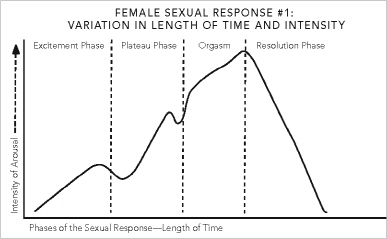
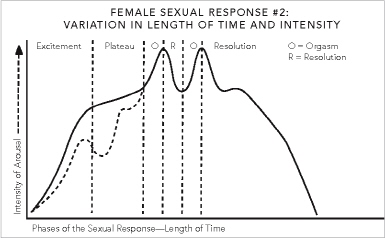

The third graph represents a discouraging dilemma for many women. For them, arousal comes naturally and easily. They hit the peak of the plateau phase, feel intensely aroused, experience waves of arousal, but stay pretty much at the same level for an extended period of time. It is as if they cannot quite make it over the hill. Finally, they give up and let down. Because there has been no orgasmic release, resolution takes several hours or more. They often are left feeling unfulfilled and wanting.
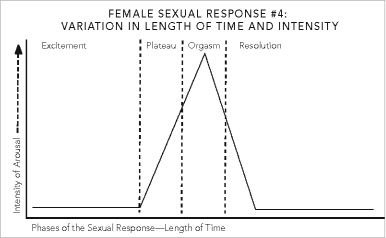
The fourth graph pictures what some women experience who were raised in alcoholic or emotionally chaotic homes. These sexually ambivalent women have serious difficulty letting themselves feel aroused—but once they do get aroused, they respond very intensely.
As soon as the orgasm ends, the resistance returns.
Using the graphs on pages 86 through 89, which summarize the primary male and female bodily responses during the four phases of the sexual experience, and the variations just described, we would encourage you to graph your own sexual response pattern. You may choose the graph closest to your experience and then vary the graph line according to your individual situation. After drawing the graph, fill in your bodily responses in as much detail as is available to you.
If you are a person with a sexual problem such as lack of arousal, difficulties with erections, or others, identify at what point your response or arousal stops. What are you aware of happening at that point? What are your thoughts or feelings? What is going on between you and your spouse? What do you sense needs to be different to allow your response to accelerate rather than stop?
We suggest that you and your spouse complete your graphs individually. Then read each other’s and have the other person explain his or hers to you. When you are the listener, work hard at sensing what your spouse experiences rather than defending yourself or describing what you experience. When you are the one relating what you feel, concentrate diligently on talking about your feelings, not on blaming your spouse. This sharing experience is an important step to understanding each other in a way that can bring enhancement to your sexual experience.